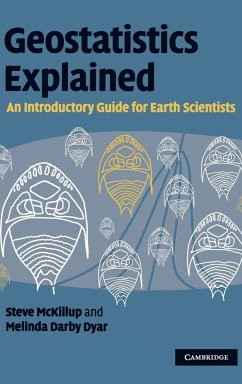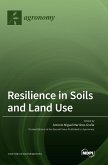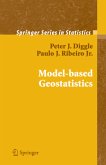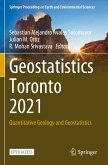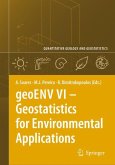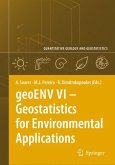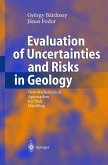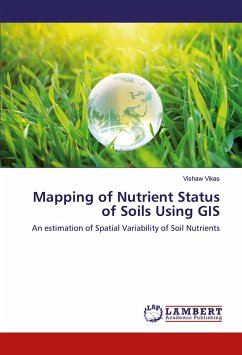Stephen McKillup, Melinda Darby Dyar, Steve Mckillup
Geostatistics Explained
An Introductory Guide for Earth Scientists
Stephen McKillup, Melinda Darby Dyar, Steve Mckillup
Geostatistics Explained
An Introductory Guide for Earth Scientists
- Gebundenes Buch
- Merkliste
- Auf die Merkliste
- Bewerten Bewerten
- Teilen
- Produkt teilen
- Produkterinnerung
- Produkterinnerung
A clear and simple introduction to geostatistics, demystifying complex concepts and making formulas and statistical tests easy to apply.
Andere Kunden interessierten sich auch für
![Resilience in Soils and Land Use Resilience in Soils and Land Use]() Resilience in Soils and Land Use73,99 €
Resilience in Soils and Land Use73,99 €![Model-based Geostatistics Model-based Geostatistics]() Peter DiggleModel-based Geostatistics97,99 €
Peter DiggleModel-based Geostatistics97,99 €![Geostatistics Toronto 2021 Geostatistics Toronto 2021]() Geostatistics Toronto 202133,99 €
Geostatistics Toronto 202133,99 €![geoENV VI - Geostatistics for Environmental Applications geoENV VI - Geostatistics for Environmental Applications]() Amílcar Soares / Maria João Pereira / Roussos Dimitrakopoulos (eds.)geoENV VI - Geostatistics for Environmental Applications81,99 €
Amílcar Soares / Maria João Pereira / Roussos Dimitrakopoulos (eds.)geoENV VI - Geostatistics for Environmental Applications81,99 €![geoENV VI - Geostatistics for Environmental Applications geoENV VI - Geostatistics for Environmental Applications]() geoENV VI - Geostatistics for Environmental Applications81,99 €
geoENV VI - Geostatistics for Environmental Applications81,99 €![Evaluation of Uncertainties and Risks in Geology Evaluation of Uncertainties and Risks in Geology]() György BardossyEvaluation of Uncertainties and Risks in Geology82,99 €
György BardossyEvaluation of Uncertainties and Risks in Geology82,99 €![Mapping of Nutrient Status of Soils Using GIS Mapping of Nutrient Status of Soils Using GIS]() Vishaw VikasMapping of Nutrient Status of Soils Using GIS39,99 €
Vishaw VikasMapping of Nutrient Status of Soils Using GIS39,99 €-
-
-
A clear and simple introduction to geostatistics, demystifying complex concepts and making formulas and statistical tests easy to apply.
Hinweis: Dieser Artikel kann nur an eine deutsche Lieferadresse ausgeliefert werden.
Hinweis: Dieser Artikel kann nur an eine deutsche Lieferadresse ausgeliefert werden.
Produktdetails
- Produktdetails
- Verlag: Cambridge University Press
- Seitenzahl: 414
- Erscheinungstermin: 4. Januar 2011
- Englisch
- Abmessung: 235mm x 157mm x 29mm
- Gewicht: 820g
- ISBN-13: 9780521763226
- ISBN-10: 0521763223
- Artikelnr.: 28110236
- Herstellerkennzeichnung
- Libri GmbH
- Europaallee 1
- 36244 Bad Hersfeld
- gpsr@libri.de
- Verlag: Cambridge University Press
- Seitenzahl: 414
- Erscheinungstermin: 4. Januar 2011
- Englisch
- Abmessung: 235mm x 157mm x 29mm
- Gewicht: 820g
- ISBN-13: 9780521763226
- ISBN-10: 0521763223
- Artikelnr.: 28110236
- Herstellerkennzeichnung
- Libri GmbH
- Europaallee 1
- 36244 Bad Hersfeld
- gpsr@libri.de
Steve McKillup is an Associate Professor in the Department of Biosystems and Resources at Central Queensland University. He has received several tertiary teaching awards, including the Vice-Chancellor's Award for Quality Teaching and a 2008 Australian Teaching and Learning Council citation 'For developing a highly successful method of teaching complex physiological and statistical concepts, and embodying that method in an innovative international textbook'. He is the author of Statistics Explained: An Introductory Guide for Life Scientists (Cambridge, 2006). His research interests include biological control of introduced species, the ecology of soft-sediment shores and mangrove swamps.
Preface
1. Introduction
2. 'Doing science': hypotheses, experiments and disproof
3. Collecting and displaying data
4. Introductory concepts of experimental design
5. Doing science responsibly and ethically
6. Probability helps you make a decision about your results
7. Working from samples: data, populations and statistics
8. Normal distributions: tests for comparing the means of one and two samples
9. Type 1 and type 2 error, power and sample size
10. Single factor analysis of variance
11. Multiple comparisons after ANOVA
12. Two-factor analysis of variance
13. Important assumptions of analysis of variance: transformations and a test for equality of variances
14. Two-factor analysis of variance without replication, and nested analysis of variance
15. Relationships between variables: linear correlation and linear regression
16. Linear regression
17. Non-parametric statistics
18. Non-parametric tests for nominal scale data
19. Non-parametric tests for ratio, interval or ordinal scale data
20. Introductory concepts of multivariate analysis
21. Introductory concepts of sequence analysis
22. Introductory concepts of spatial analysis
23. Choosing a test
Appendix A. Critical values of chi-square, Student's t and F
Appendix B. Answers to questions
References
Index.
1. Introduction
2. 'Doing science': hypotheses, experiments and disproof
3. Collecting and displaying data
4. Introductory concepts of experimental design
5. Doing science responsibly and ethically
6. Probability helps you make a decision about your results
7. Working from samples: data, populations and statistics
8. Normal distributions: tests for comparing the means of one and two samples
9. Type 1 and type 2 error, power and sample size
10. Single factor analysis of variance
11. Multiple comparisons after ANOVA
12. Two-factor analysis of variance
13. Important assumptions of analysis of variance: transformations and a test for equality of variances
14. Two-factor analysis of variance without replication, and nested analysis of variance
15. Relationships between variables: linear correlation and linear regression
16. Linear regression
17. Non-parametric statistics
18. Non-parametric tests for nominal scale data
19. Non-parametric tests for ratio, interval or ordinal scale data
20. Introductory concepts of multivariate analysis
21. Introductory concepts of sequence analysis
22. Introductory concepts of spatial analysis
23. Choosing a test
Appendix A. Critical values of chi-square, Student's t and F
Appendix B. Answers to questions
References
Index.
Preface
1. Introduction
2. 'Doing science': hypotheses, experiments and disproof
3. Collecting and displaying data
4. Introductory concepts of experimental design
5. Doing science responsibly and ethically
6. Probability helps you make a decision about your results
7. Working from samples: data, populations and statistics
8. Normal distributions: tests for comparing the means of one and two samples
9. Type 1 and type 2 error, power and sample size
10. Single factor analysis of variance
11. Multiple comparisons after ANOVA
12. Two-factor analysis of variance
13. Important assumptions of analysis of variance: transformations and a test for equality of variances
14. Two-factor analysis of variance without replication, and nested analysis of variance
15. Relationships between variables: linear correlation and linear regression
16. Linear regression
17. Non-parametric statistics
18. Non-parametric tests for nominal scale data
19. Non-parametric tests for ratio, interval or ordinal scale data
20. Introductory concepts of multivariate analysis
21. Introductory concepts of sequence analysis
22. Introductory concepts of spatial analysis
23. Choosing a test
Appendix A. Critical values of chi-square, Student's t and F
Appendix B. Answers to questions
References
Index.
1. Introduction
2. 'Doing science': hypotheses, experiments and disproof
3. Collecting and displaying data
4. Introductory concepts of experimental design
5. Doing science responsibly and ethically
6. Probability helps you make a decision about your results
7. Working from samples: data, populations and statistics
8. Normal distributions: tests for comparing the means of one and two samples
9. Type 1 and type 2 error, power and sample size
10. Single factor analysis of variance
11. Multiple comparisons after ANOVA
12. Two-factor analysis of variance
13. Important assumptions of analysis of variance: transformations and a test for equality of variances
14. Two-factor analysis of variance without replication, and nested analysis of variance
15. Relationships between variables: linear correlation and linear regression
16. Linear regression
17. Non-parametric statistics
18. Non-parametric tests for nominal scale data
19. Non-parametric tests for ratio, interval or ordinal scale data
20. Introductory concepts of multivariate analysis
21. Introductory concepts of sequence analysis
22. Introductory concepts of spatial analysis
23. Choosing a test
Appendix A. Critical values of chi-square, Student's t and F
Appendix B. Answers to questions
References
Index.

